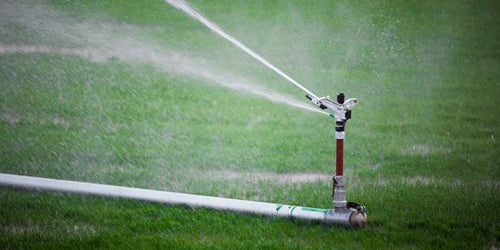Free Shipping orders over $149
Free Shipping
on all orders over $149

If you want to maintain the lush green paradise of your lawn during the hot summer months — it can take a significant investment of time and money.
It’s important to use the right materials for the best return on that investment. Today, we’ll explore which plastic pipes are the best option for your sprinkler system.
To that end, sprinklers have evolved over time. Until the mid-1970s, black steel pipes dominated the sprinkler piping market. But plastic pipes have taken over due to their flexibility and versatility.

Source: Freepik
Are you using a CPVC or PVC sprinkler piping system? Which is the better choice and why?
Strap in because we’re about to get technical.
PVC is an abbreviation for Polyvinyl Chloride — which is an artificial plastic. That means the plastic is processed with chemicals to enhance its durability and tensile strength.
The chemical composition of PVC is two carbon atoms joined by three hydrogen atoms and one chlorine atom.
Single bonds link all the atoms to form one molecule unit. Otherwise known as a monomer. Then, multiple monomers are attached to each other to form chains called a polymer. The joined polymer results in a PVC pipe.

Source: pvcpipesupplies.com
Did you know? PVC pipes can last for 50 years. And the first PVC pipe was first introduced in the US in the 1950s.
There are two main variants of PVC pipe:
For installation, the PVC pipe is cut with a saw and cement glue joins the pipe pieces together. On the other hand, copper and iron pipes are fused together through welding.
When it comes to heat, PVC handles temperatures up to 140° Fahrenheit. Temperatures above that threshold soften the PVC pipe, causing the joints to separate. The ensuing disintegration also releases harmful airborne toxins.
The minimum working temperature recommended is 33° F.
CPVC stands for Chlorinated Polyvinyl Chloride. The chlorination process of the Polyvinyl Chloride resin makes it a thermoplastic with a sturdier chemical makeup.
CPVC has two carbon atoms that are attached to each other by two hydrogen atoms and two chlorine atoms. The result is a double carbon unit. Hence, the single unit of CPVC is chemically stronger than that of PVC.

Source: pvcpipesupplies.com
The key difference in the chemical composition between PVC and CPVC is the higher amount of chlorine in CPVC.
CPVC is made of about 40 percent chlorine atoms that form the bonding sites. Hydrogen atoms fill the other 60 percent. However, PVC only comprises 25 percent chlorine atoms at the bonding sites.
The higher chlorine content allows CPVC to endure higher temperatures and resist fire and corrosion better than PVC.
Guess what? The first CPVC pipe was engineered in 1959 and is still working today.
CPVC pipe comes in two sizes:
The installation process is similar to that of PVC pipes.
CPVC pipe has a higher heat resistance of 200° F. Thanks to the chlorine content, the structure is firm and intrinsically fire retardant. But CPVC also handles a minimum temperature of 33° F.
The main distinguishing factor between CPVC and PVC is their heat withstanding capacity. CPVC handles temperatures up to 200° F, while PVC’s maximum heat is 140° F.
Here are other key variations that’ll help you distinguish CPVC from PVC.
| CPVC | PVC |
| Used for hot water lines | Used for cold water lines |
| The solvent cements must meet ASTM F493 specifications | The solvent cements must meet ASTM D2564 specifications |
| Available in nominal pipe size and copper tube sizes | Available in nominal pipe size only |
| The standard length is 10' | The standard length is either 10' or 20' |
| 8200 PSI (pounds per square inch) tensile strength | 7500 PSI (pounds per square inch) tensile strength |
| Greater flexibility | Less flexible |
| Comes in either light grey, off-white or yellow | Comes in white or dark grey |
PVC and CPVC pipes are sometimes used interchangeably. Manufacturers use either PVC or CPVC for pipes and fittings in homes, for commercial use, and at recreational sites.
| For Domestic Use | For Business Use | For Recreational Use |
|
|
|
The most important factor to consider when choosing between PVC and CPVC is the intended purpose.
Both PVC and CPVC pipes are used interchangeably. For instance, in piping and fittings or irrigation and water distribution. However, their unique temperature thresholds and different chemical compositions set them apart.
For example, the chlorine atom content difference between PVC and CPVC enables CPVC to handle harsh chemicals that would otherwise corrode the PVC pipe and some metal pipes.
PVC pipe is most suitable for:
CPVC pipe is commonly used for:
And that concludes our short technical class on the basics of CPVC and PVC.
At the Sprinkler Supply Store, we’ve got a variety of PVC fittings, sprinklers, drip irrigation, wiring and electric supplies, and much more.
We’ve gone a step further and compiled some great tips and guides on landscaping and sprinkler system management. You can learn how to garden and adjust sprinkler heads, all about drip irrigation, and much more!
We love to hear from you. Feel free to contact us if you have any queries or concerns about your order. Our team is always ready to chat and help you out!

Ugene Columbo Jr. | Customer Review